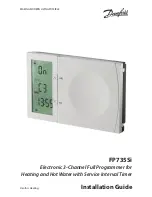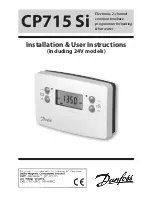
Version: 010905
ShowCase 3264 MANUAL Page 5 of 12
OPERATION
M/E MIX/EFFECTS OUTPUTS
In this manual, the Folsom VFC-2200 dual video format converters are referred to as Mix/Effects or M/E units. This
is because they are capable of performing mixing and wiping between inputs, and because effects (resizing,
positioning, etc.) can be used. The ShowCase system is capable of controlling up to 6 M/E output channels.
These M/E channels are controlled and indicated by the rows of controls located to the right of the numbers 1-6 on
the left side of the panel. The format converter video connections are as follows:
VIDEO IN A & B
FEED WITH ROUTER OUTPUTS (75 OHM SWITCH ON - DO NOT USE LOOP)
OUTPUT #1
M/E PROGRAM (PGM) OUTPUT
OUTPUT #3
M/E PRESET (PST) OUTPUT (CONFIGURE ON MENU: OUT #3 PREV <B/A>)
AUX AUXILIARY OUTPUTS
The ShowCase system controls a 32 input by 16 output router. Each M/E channel uses 2 router outputs, totaling
12. The remaining 4 router outputs are called Auxiliary or AUX Busses. These outputs are controlled and
indicated by the rows of controls located to the right of the letters A-D on the left side of the panel.
KEYPAD
The numeric KEYPAD is used to set values into the various panel registers. When numbers are entered on the
KEYPAD, they appear in the ones place on the KEYPAD DISPLAY and digits shift left. The STORE key lights
when pressed, and numbers entered either beforehand or afterwards are entered into a register when any register
type key is pressed, at which time the STORE key goes out. Pressing the STORE key a second time latches it on
to allow rapid storing of the same or different values into registers without having to press the STORE key every
time. The CLEAR key clears the display and resets the STORE key.
CHANNEL SELECTION
Any or all of the 6 M/E and 4 AUX Busses can be selected for simultaneous control. The SELECT ONE function
key allows only 1 output channel to be controlled at a time. Pressing the SELECT MULTI function key changes the
channel SELECT keys to an alternate-action mode, allowing multiple channels to be selected at once. After
pressing SELECT ONE, the next 4 presses of SELECT MULTI recall 4 different combinations of select keys that
have previously been set. All selected output channels operate simultaneously when a global function is used such
as MIX, WIPE, AUTO TRANS, EFFECT, PAN & ZOOM, etc. Settings applied to functions (such as AUTO TRANS
duration) are stored in all selected channels where applicable. When SEQ is used to recall a preset, the channel
selects that were in effect when the preset was stored are recalled into the last select multi register and that
register is recalled. This allows subsequent global operations, such as TAKE, to act upon the preset channels.
The SELECT ONE or SELECT MULTI buttons will then restore the selects that were in effect before the recall.
INPUT SELECTION
The 32 video input sources are selected into a preset PST state using the 32 input select keys. Above each input
key is a column of indicator LEDs that indicate the preset PST and program PGM state of each channel. M/E
channels have an additional row of yellow TRANS LEDs that indicate a transition is ready to begin. When an input
key is pressed, the green PST LEDs above that key light on all selected channels. The PST input is sent to the
output of a channel when a TAKE is executed. When a take is completed, this input becomes the PGM input and
its red PGM LED lights. The input key lamps light for all inputs that are currently PST on selected channels.
On each M/E channel, the PST input is automatically routed into the not-on-program input of the video format
converter. If an AUTO TRANS or manual transition is in process, the PST input will not be routed until the
transition is completed. When routing occurs, the converter's input configuration register matching the input key
number is recalled, making the signal lock-on process as fast as possible. A short delay is then implemented to
allow for the signal lock-on to complete before the TRANS LED is lit and transitioning is enabled. If an AUTO
TRANS is requested during the lock-on delay or a previous AUTO TRANS is still in process, it will begin
immediately after these processes complete.






























